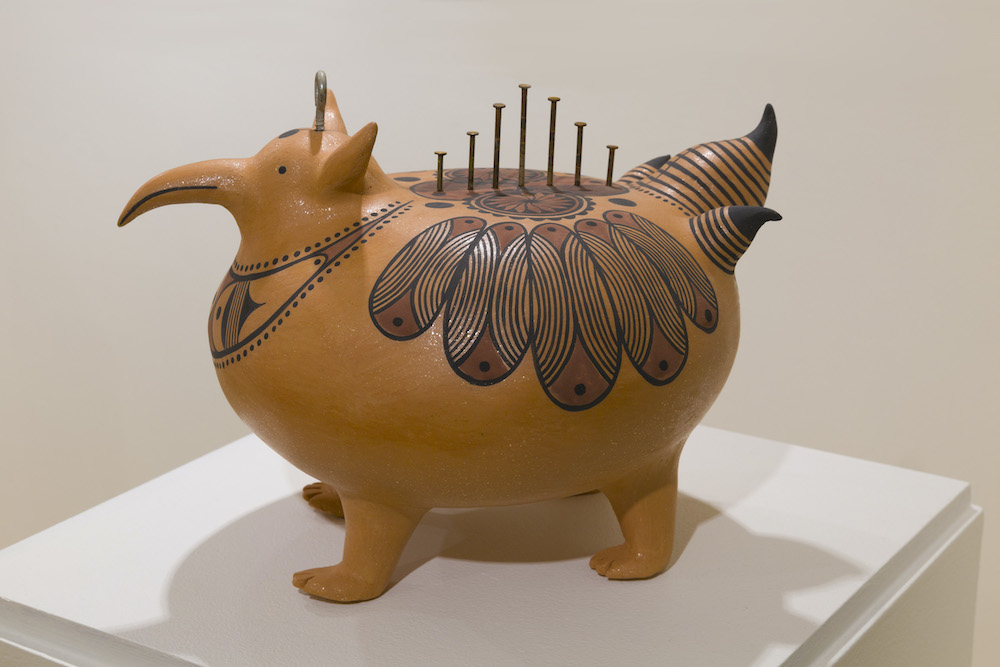One expects certain things from a good ceramic biennial: personal visions, agile skill sets, revelatory juxtapositions, and an insightful contemporary theme to weave them all together. Happily, this third iteration of the clay biennial at the Craft Contemporary, titled “Wayfinding,” offers vision and agility to spare. Although the theme is rather broadly drawn—referring to clay’s origins in land and water and embracing issues of cultivation, migration and sustainability—the works revel in their florid diversity, overflowing with effusive vitality. Forging various factual and fictional connections between human culture and the natural world, its tone feels at once celebratory and mournful. That it gets a little weird at times is just an added bonus.
Organized by Holly Jerger, the exhibition is spread throughout the museum’s three levels, each exuding its own sensibility. The gallery on the second floor is most down-to-earth, emphasizing humble vernacular idioms. A sense of cultural vulnerability, and durability, is immediately set by lourdes jiménez-pulido’s arc of dirt strewn with unfired clay vessels, while panels set with decals and personal objects lend an air of poignancy. Of Pueblo and Navajo descent, Rowan Harrison digs his own clay in New Mexico and uses it to create traditionally inspired vessels impaled with rusty nails and other bits of metal to represent the intrusion of industrial society, as in his Four Legged Mythological Animal Form (2023) which has an eye screw jutting incongruously from the top of its head.

Rowan Harrison, Four legged Mythological Animal Form, 2023, courtesy of Craft Contemporary, Los Angeles.
Veering joyfully into the grotesque, Charles Snowden’s meditations on antiquity, sexuality, mortality and totemic symbolism rank among the show’s most striking offerings. To Ward Speech (2021) depicts an upraised hand adorned with various farmyard denizens, from a snake to a rooster to a curled-up dog, suggesting an archaic household talisman. Invocation of Worms (2021), a moon-faced, wall-mounted funerary vessel with four beady eyes and a geometric lid, plus a snail for an earring and metal bedpan below, evokes the eerie texture of a dream, as does Apotropaic Threshold (2021), his jaunty impish figure dangling from a hook, festooned with terracotta bells. Flaunting a floppy snake-faced penis, rigid phallic horns and a suggestive, vulvic cap, it’s probably not the best choice for the baby’s crib. Grounding these uncanny visions in mundane reality is Snowden’s eloquent floor installation of cracked terracotta tiles, strewn with sculpted detritus, like refuse from a restaurant. Live weeds poke through the moldy tiles, lending the scene an air of regenerative melancholy. More overtly seductive are Ryan Flores’ lushly glazed vegetative still lifes, which seem to overspill their frames, profuse to the point of decay.
The elegiac sensuality continues in the main, third floor gallery, with Courtney Mattison’s extraordinary wall-mounted centerpiece, Our Changing Seas IV (2016–19), which displays a panoply of diverse corals clustered together to suggest a swirling galaxy or Taoist yin and yang symbol. Mattison has a dual degree in marine ecology and ceramics from Brown University, so the work’s striking verisimilitude to the structures of real coral is no accident. Presenting a plethora of vivid, multi-colored polyps, lobes and branches, and mesmerizing in its tactile variety, the work entices the viewer to confront the complexity and fragility of this vibrant underwater life form; now suffering the effects of climate change from ocean warming and acidification due to humanity’s short-sightedness. Through her use of stoneware and porcelain, Mattison’s sculptures replicate the calcium carbonate materials used by corals to create their reefs.

Charles Snowden, Invocation of Worms, 2021. Image courtesy of Craft Contemporary, Los Angeles.
Echoing her work’s aura of abundance, Visalia-based David Hicks derives inspiration from agriculture, presenting dense arrays of giant bulbs and blooms in a bountiful cornucopia, while Chilean-born Paz G presents a hillside capped with disarmingly eclectic vessels honoring their ancestors, as if they were still linked to the earth, at least in spirit. Nearby, Lizette Hernández’s shimmery Raku wall forms resemble rawhide carapaces, while Connie Martin Trevino offers a fanciful tribe of globular, darkly glazed ceramic vessels, which suggest an unlikely hybrid of humans and corals; in her imagined narrative, they represent a race of Black African people who chose to give their lives to the sea rather than be enslaved. And don’t overlook Amia Yokoyama’s porcelain anime slime girl, whose drippy surface conjures an excess of viscous bodily fluids.
But the award for the trippiest work goes to Sam Shoemaker, whose interdisciplinary sculptures created from ceramic, sawdust and fungi highlight his expertise in mycology. Set on loopy bases that echo the eccentric forms of his vessels—which look like tree trunks, rocks, slabs, even little dwellings—his works are crafted to house live mushroom specimens (thankfully not cordyceps), which, upon maturation, are preserved in situ to create sinuous, fungus-forward tableaux. In its quirky and utterly sincere reimagining of clay’s utilitarian roots, his work makes a persuasive argument, not just for the continued relevance of a ceramic biennial, but for the adaptability of this most humble and enduring of art forms.


